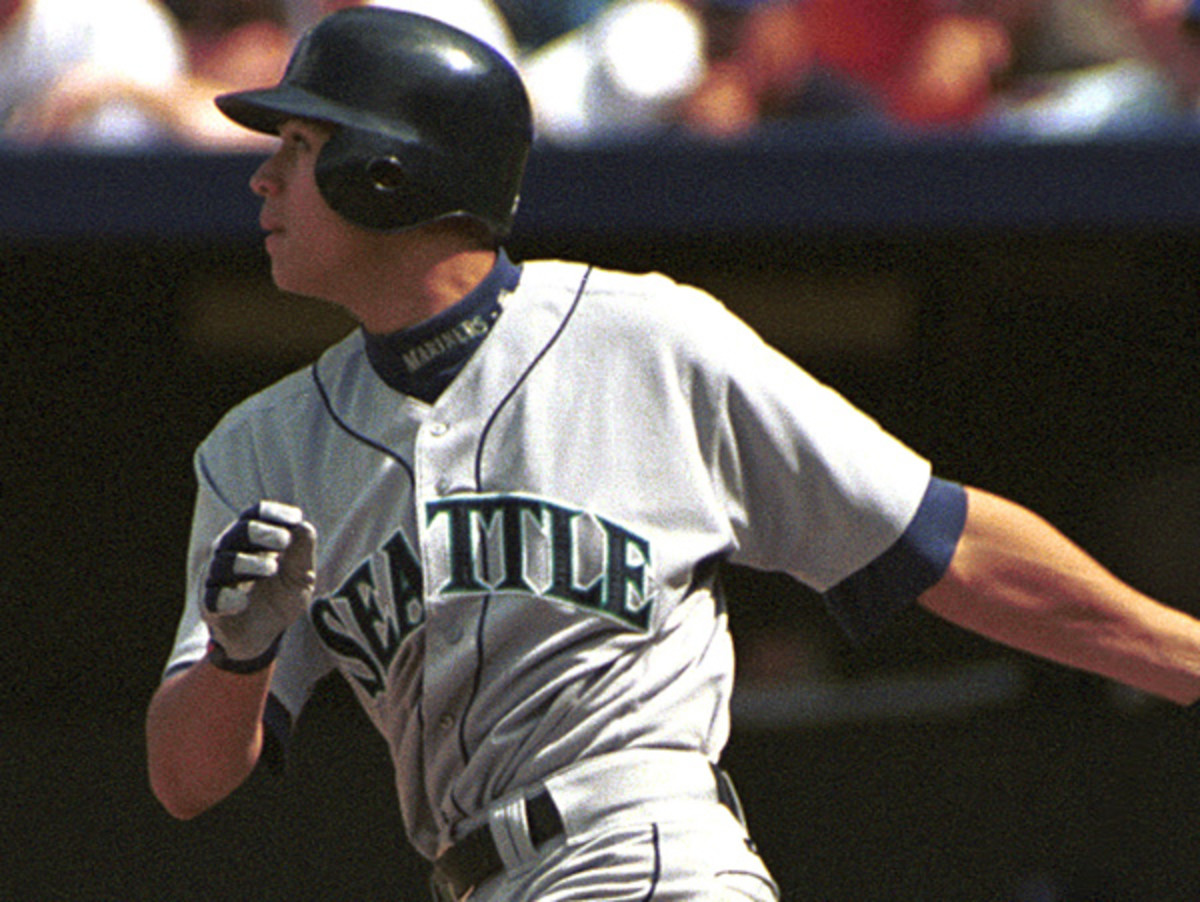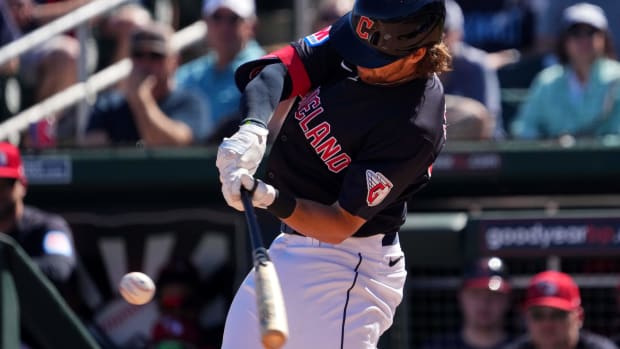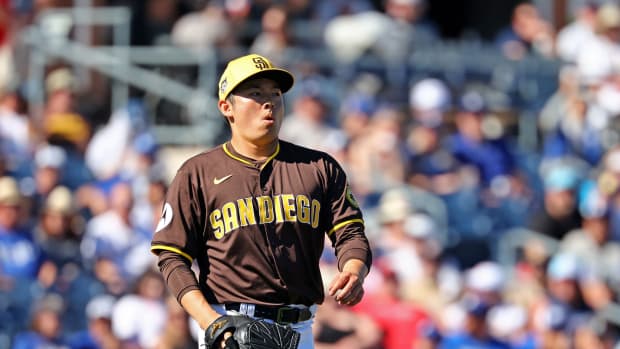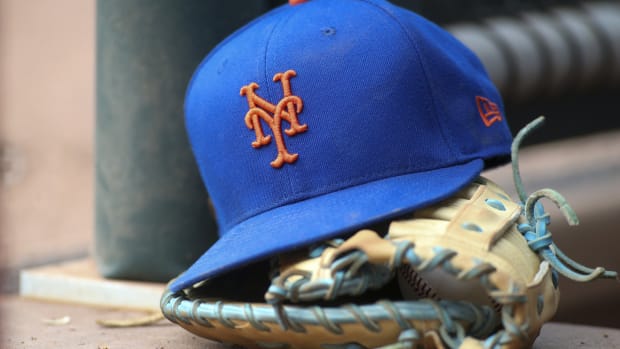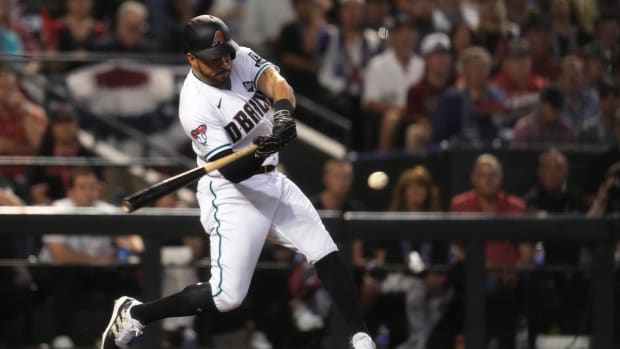Top studs and duds: The best and worst No. 1 picks in MLB draft history
Alex Rodriguez was the No. 1 overall pick in 1993 out of high school for the Mariners. (Getty Images)
On Thursday, the Astros will do something no team has ever done in MLB history: Make the No. 1 pick in the Rule 4 amateur draft for the third year in a row. And as Houston’s previous two picks (shortstop Carlos Correa in 2012 and pitcher Mark Appel in 2013) work their way toward the majors, let's take a quick look back at the five best and five worst No. 1 picks in the previous 47 years of the draft.
The Five Best
1. Chipper Jones, SS, Braves, 1990
By career wins above replacement, Alex Rodriguez has been by far the most valuable first-round pick in draft history, but no team ever got more out of the No. 1 overall choice than the Braves got from Chipper Jones. Rodriguez, who went 1/1 in 1993, chased big free agent money at the first opportunity, leaving Seattle after compiling 38 WAR in his team-controlled years. Ken Griffey Jr. (1987) forced a trade to his home city of Cincinnati after 11 years with the Mariners, but Jones, a regional high school shortstop who settled in at third base in the major leagues, spent his entire 19-year, soon-to-be Hall of Fame career with team that drafted him.
Jones compiled 85 WAR for Braves teams that made the postseason in 12 of those 19 seasons and won the World Series in his rookie year of 1995. Jones was paid handsomely by Atlanta to be sure, but he never earned more than $16 million in a single season and never signed a nine-figure contract. He was however, one of the best players of his era, and one of the best switch-hitters and third baseman in baseball history.
2. Ken Griffey Jr., CF, Mariners, 1987
In their team-controlled years, Griffey was every bit as valuable as Rodriguez, compiling 37 WAR to Rodriguez's 38, and likely would have surpassed Rodriguez over that span if his sixth major league season hadn't ended early due to the 1994 strike. Unlike Rodriguez, Griffey stuck around to add another 33.6 WAR to that total, and when he ultimately did engineer his way out of Seattle, he did so via a trade to his hometown Reds that brought capable replacement Mike Cameron to the Mariners.
Griffey was also a transformative player for Seattle's franchise. The Braves had already turned things around and won a pair of pennants before Jones reached the majors, but the Mariners had never had a winning season before Griffey joined the team. With Junior in center, winning 10 straight Gold Gloves and the 1997 American League MVP award, Seattle enjoyed its first five winning seasons and its first two postseason berths. The Mariners' comebacks to win the American League West and the ALDS in 1995 have been credited with proving the viability of baseball in Seattle and motivating the construction of Safeco Field. The team's iconic moment from that postseason is Griffey racing around from first base on Edgar Martinez's 11th inning double to score the series-winning run in Game 5 of the Division Series against the Yankees.
3. Alex Rodriguez, SS, Mariners, 1993
Rodriguez was the best player ever drafted with the top overall pick, having thus far compiled 116 WAR, 654 home runs, 2,939 hits and three MVP awards. However, he proved to be a poor investment for all three of his major league teams. He burned the Mariners by bolting for free agency after his age-24 season. He burned the Rangers, who signed him to a record-obliterating 10-year, $252 million contract by engineering a trade to the Yankees after just three seasons. Finally, he burned New York in multiple ways. First, he opted out of his initial 10-year deal and leveraged the team for a new one worth $275 million only to go into decline long before it is scheduled to end after the 2017 season. In addition, his violations of MLB's drug policy resulted in his suspension for the entire 2014 season.
Given what followed after he left their respective teams, one could argue that the Mariners and Rangers both benefited from Rodriguez's departures, and that the Yankees are benefiting this year from his suspension. I can't rank that player above Jones and Griffey.
Mauer might have had a chance of passing Rodriguez on this list as well if injuries hadn't forced the longtime star catcher's permanent move to first base this season. It's hard to top taking a local high school kid (Mauer was born and raised in St. Paul) with the No. 1 overall pick and watching him quickly emerge as one of the best catchers in baseball history, as Mauer was doing before his health problems. He can still boast the 2009 AL MVP award and slash-stat triple crown, and he remains the only catcher ever to win three batting titles, with a JAWS peak score (combined bWAR for his top seven seasons) that ranks fifth all-time among catchers. He'll be a Twin through his age-35 season, and should go into the Hall of Fame as one as well. Meanwhile, his career bWAR total ranks fourth among all number-one picks behind only the top three men on this list.
5. Darryl Strawberry, OF, Mets, 1980
Strawberry was a slam-dunk Hall of Famer in his 20s, hitting .263/.359/.516 (144 OPS+) while averaging 31 home runs, 92 RBIs and 22 stolen bases over his first nine seasons, making eight All-Star teams and winning the Rookie of the Year award in the process. Along the way, he was a central player in the Mets' mid-1980s turnaround and the team's 1986 World Series win. That all fell apart soon after he signed as a free agent with his hometown Dodgers after the 1990 season, as his off-field problems overwhelmed and ultimately derailed his baseball career. Two decades later, even Strawberry must wonder what might have been had he stayed in New York, where he experienced a brief resurrection with the Yankees in the late '90s. His post-free-agency troubles aside, Strawberry was worth 36.5 wins above replacement to the Mets, a return on investment topped only by what the four men above him gave to the teams that drafted them first overall.
Matt Bush, taken first overall in 2004, never made it to the majors. (Ronald Martinez/Getty Images)
The Five Worst
1. Matt Bush, SS, Padres, 2004
San Diego selected local two-way high-school star Bush with the top pick in 2004 because it was unwilling to meet the signing-bonus demands of the best players in that year's draft, second-overall pick Justin Verlander and fellow college stars Jered Weaver and Stephen Drew; the latter two were the Padres' top targets before discussions with agent Scott Boras convinced them they'd be too expensive. San Diego still wound up shelling out a $3.15 million signing bonus to Bush (Weaver, the least expensive of the other three, got $4 million from the Angels), who is one of just three top overall picks from before 2012 who never made it to the majors.
Had Bush simply been a bust or, like other players on this list, suffered a career-altering injury, he wouldn't necessarily have been the worst top pick ever. He earned that distinction with his off-field behavior. Bush was arrested for assault and underage drinking within weeks of being drafted, and his baseball career foundered following a move from shortstop to the mound in 2007 and Tommy John surgery, which wiped out his entire 2008 season. Two more incidents of drunken assault led to his being traded to Toronto, then being released by the Blue Jays in 2009. The Rays signed him as a pitcher in 2010, but during spring training in 2012, he was arrested for a hit-and-run DUI, an incident which effectively ended his baseball career at the age of 26. He is currently serving a 51-month prison sentence in Florida.
2. Steve Chilcott, C, Mets, 1966
Money had nothing to do with why the Mets drafted high school catcher Steve Chilcott over college slugger Reggie Jackson in the second-ever Rule 4 draft. Jackson, drafted second overall, signed with the Athletics for $85,000. Chilcott signed with the Mets for $75,000. Mets executive Joe McDonald claimed the team was drafting for need, which is equally dubious as an excuse and a strategy. Jackson claimed New York, and team president George Weiss specifically, passed him over because he had a Hispanic girlfriend. Whatever the reason, Chilcott did show promise in his first full professional season, hitting .290/.370/.467 in A-ball at the age of 18, but he suffered a shoulder injury that season and was never the same player thereafter. He was out of baseball by age 24, having never reached the major leagues.
3. Danny Goodwin, C, White Sox, 1971
Given that just six of the next 11 men off the board in the 1971 draft made the majors and those six combined to be worth 1.2 wins below replacement in their careers, the White Sox can't really be singled out for picking high school catcher Goodwin, although the first round did yeild future Hall of Famer Jim Rice and longtime pitching stars Frank Tanana and Rick Rhoden. They can, however, be singled out for being the only team in the first 49 years of the draft to use the top overall pick on a player they were then unable to sign. Worse yet, in those early days of the draft, there was no compensation for such failures (today, teams get make-up picks the next year). So the White Sox got literally nothing for their pick.
Goodwin subsequently became the only player ever taken with the top overall pick twice, when the Angels drafted him 1/1 in 1975. Goodwin was still a bust, finishing his career at the age of 28 having been worth 1.7 wins below replacement, but at least he played for California and subsequently proved of value in the trade that brought Dan Ford from the Twins to the Angels.
4. Brien Taylor, LHP, Yankees, 1991
Of all the players drafted with the top overall pick, only Bush, Chilcott and Taylor failed to make the major leagues to date. Whereas Bush and Chilcott were mistakes from the moment their names were announced, however, Taylor was the right pick with the wrong result. A monstrously talented high school lefty, Taylor was rated the top prospect in the game by Baseball America the winter after his selection and posted a 2.57 ERA with 187 strikeouts in 161 1/3 innings in 1992 his first professional season. The talent was clearly there, even after he struggled a bit in Double A in 1993. That December, however, Taylor suffered a torn capsule and labrum in his pitching shoulder while defending his brother in a fight and missed the entire 1994 season. He returned to the mound in 1995, but he was never again effective and never again pitched above A-ball, last appearing in five games of relief in the Indians' system in 2000.
5. Al Chambers, OF, Mariners, 1979






























